 W
WThe Cambaridae are the largest of the three families of freshwater crayfish, with over 400 species. Most of the species in the family are native the United States east of the Great Divide and Mexico, but fewer range north to Canada, and south to Guatemala and Honduras. Three live on the island of Cuba. The species in the genus Cambaroides are the only found outside North America, as they are restricted to eastern Asia.
 W
WThe acocil is a species of crayfish in the family Cambaridae. It is endemic to Mexico, where it is known from Jalisco and Puebla.
 W
WThe Big Sandy crayfish, Cambarus callainus, are freshwater, tertiary burrowing crustaceans of the family Cambaridae. They are found in the streams and rivers of Appalachia in Virginia, West Virginia, and Kentucky, in what is known as the Big Sandy watershed. Populations are often mistaken with Cambarus veteranus, but morphological and genetic data suggests that these are separate taxa; however, both are protected under the Endangered Species Act. There is very little information available on the Big Sandy crayfish because it is a relatively new species.
 W
WThe blue crayfish, sometimes called the electric blue crayfish, the sapphire crayfish, or the Florida crayfish, is a species of freshwater crayfish endemic to Florida in the United States. Its natural range is the area east of St. Johns River and all of Florida from Levy County and Marion County southwards, as well as on some of the Florida Keys. It is included on the IUCN Red List as a species of Least Concern. The blue crayfish is frequently kept in freshwater aquaria. In the wild, this species varies from brown-tan to blue, but the aquarium strain has been selectively bred to achieve a brilliant cobalt blue color.
 W
WCambarellus is a genus of small freshwater crayfish in the family Cambaridae. The 19 species are found in Mexico and the Gulf States of the United States. Among the Mexican species, C. areolatus, C. patzcuarensis, and C. prolixus are considered seriously threatened by the IUCN, and C. alvarezi is already extinct. C. chihuahuae was also believed to be extinct until rediscovered in 2012. C. alvarezi and four undescribed, extinct Cambarellus species were restricted to desert spring systems in southwestern Nuevo León; each one shared its habitat with a Cyprinodon pupfish.
 W
WCambarellus diminutus is a species of crayfish in the family Cambaridae. It is endemic to the United States. It is native to Mississippi and Alabama, and is listed as Data Deficient on the IUCN Red List.
 W
WCambarellus lesliei is a species of crayfish in the family Cambaridae. It is native to Alabama and Mississippi in the United States. It is known commonly as the angular dwarf crawfish.
 W
WThe acocil is a species of crayfish in the family Cambaridae. It is endemic to Mexico, where it is known from Jalisco and Puebla.
 W
WCambarellus patzcuarensis is a small, threatened species of crayfish in the family Cambaridae. It is native to Mexico and often kept in aquariums.
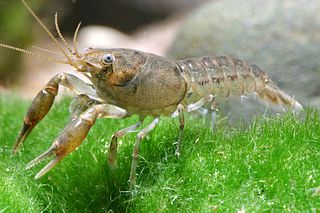 W
WCambarellus shufeldtii is a species of crayfish in the family Cambaridae. It is native to the United States, where it occurs in Alabama, Arkansas, Illinois, Kentucky, Louisiana, Mississippi, Missouri, Tennessee, and Texas. It is present in Georgia as an introduced species. It is known commonly as the Cajun dwarf crayfish.
 W
WCambarellus zacapuensis, also known as Zacapu acocil or Zacapu dwarf crayfish, is a small crustacean endemic to the Angulo River basin, observed mainly in Zacapu Lagoon.
 W
WCambaroides is a genus of freshwater crayfish from eastern Asia. Together with Astacus, they are the only crayfish native to Asia. Cambaroides contains about six species:Cambaroides dauricus (Pallas, 1772) Cambaroides japonicus De Haan, 1841) Cambaroides koshewnikowi Birstein & Vinogradov, 1934 Cambaroides schrenckii (Kessler, 1874) Cambaroides similis (Koelbel, 1892) Cambaroides wladiwostokiensis Birstein & Vinogradov, 1934
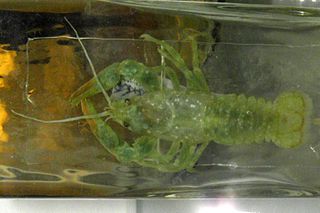 W
WCambaroides dauricus is a species of crayfish endemic to north-eastern China, the Korean Peninsula and neighbouring parts of Russia.
 W
WCambaroides japonicus, also known as Japanese crayfish , is a species of crayfish endemic to Japan.
 W
WCambaroides schrenckii is a species of crayfish endemic to north-eastern China and Russia. It is a freshwater species that also occurs in some brackish water areas. It occurs in habitats with still water, typically no more than 1 metre deep. It was named after Leopold von Schrenck.
 W
WCambarus is a large and diverse genus of crayfish from the United States and Canada. The adults range in size from about 5 centimeters (2 in) up to approximately 15 centimeters (6 in).
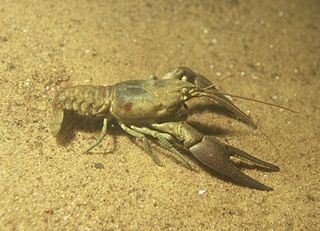 W
WCambarus aculabrum is a rare species of crayfish known by the common name Benton cave crayfish. It is native to Arkansas in the United States, where it is known from only four locations. It is a federally listed endangered species of the United States.
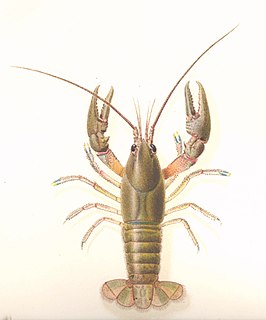 W
WCambarus bartonii is a species of crayfish native to eastern North America, where it is called the common crayfish or Appalachian brook crayfish.
 W
WCambarus chasmodactylus, commonly called the New River Crayfish, is a species of crayfish endemic to the New River drainage system
 W
WCambarus davidi, also known as the Carolina ladle crayfish, is a species of crayfish in the family Cambaridae. It is endemic to central North Carolina, where it is restricted to the upper Neuse and Cape Fear river basins.
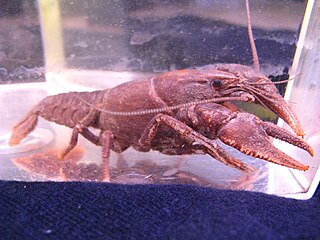 W
WCambarus georgiae, the Little Tennessee crayfish, is a species of crayfish in the family Cambaridae. It is found in North America.
 W
WCambarus robustus, known generally as the robust crayfish or big water crayfish, is a species of crayfish in the family Cambaridae. It is found in North America.
 W
WCambarus scotti, the Chatooga crayfish, is a species of crayfish in the family Cambaridae. It is found in North America.
 W
WFallicambarus is a genus of crayfish in the family Cambaridae from the United States and Canada. It includes 19 species, of which five are on the IUCN Red List as vulnerable species (VU), two as endangered species (EN) and one as a critically endangered species (CR). Only F. fodiens is widespread, occurring over a large part of the Central United States, and extending into Ontario; the other species are all restricted to three states or fewer from Texas to Florida.Fallicambarus burrisi (Fitzpatrick, 1987) – Alabama, Mississippi Fallicambarus byersi (Hobbs, 1941) – Alabama, Florida, Mississippi Fallicambarus caesius Hobbs, 1975 – Arkansas Fallicambarus danielae Hobbs, 1975 – Alabama, Mississippi Fallicambarus devastator Hobbs & Whiteman, 1987 – Texas Fallicambarus dissitus (Penn, 1955) – Arkansas, Louisiana Fallicambarus fodiens (Cottle, 1863) – Ontario, central United States Fallicambarus gilpini Hobbs & Robison, 1989 – Arkansas Fallicambarus gordoni (Fitzpatrick, 1987) – Mississippi Fallicambarus harpi Hobbs & Robison, 1985 – Arkansas Fallicambarus hortoni Hobbs & Fitzpatrick, 1970 – Tennessee Fallicambarus houstonensis Johnson, 2008 – Texas Fallicambarus jeanae Hobbs, 1973 – Arkansas Fallicambarus kountzeae Johnson, 2008 – Texas Fallicambarus macneesei (Black, 1967) – Louisiana, Texas Fallicambarus oryktes Penn & Marlow, 1959 – Alabama, Louisiana, Mississippi Fallicambarus petilicarpus Hobbs & Robison, 1989 – Arkansas Fallicambarus strawni (Reimer, 1966) – Arkansas Fallicambarus wallsi Johnson, 2011
 W
WFallicambarus burrisi, the burrowing bog crayfish, is a species of crayfish in the family Cambaridae. It is found in a limited range in southeastern Mississippi and southwestern Alabama.
 W
WFaxonius is a genus of malacostracans in the family Cambaridae. There are more than 20 described species in Faxonius. It includes the rusty crayfish an invasive species in North America, and three species, F. virilis,F. immunis and F. limosus that are invasive species in Europe.
 W
WFaxonius immunis is a species of crayfish in the family Cambaridae. It is native to North America and it is an introduced species in Europe, where it lives along the Upper Rhine. Its common names include calico crayfish and papershell crayfish.
 W
WFaxonius virilis is a species of crayfish known as the virile crayfish, northern crayfish, eastern crayfish, and lesser known as the lake crayfish or common crawfish. Faxonius virilis was reclassified in August 2017, and the genus was changed from Orconectes to Faxonius. It is native to eastern United States and southeast Canada.
 W
WThe marbled crayfish or Marmorkrebs, is a parthenogenetic crayfish that was discovered in the pet trade in Germany in the 1990s. Marbled crayfish are closely related to the "slough crayfish", Procambarus fallax, which is widely distributed across Florida. No natural populations of marbled crayfish are known. Information provided by one of the original pet traders as to where the marbled crayfish originated was deemed "totally confusing and unreliable". The informal name Marmorkrebs is German for "marbled crayfish".
 W
WOrconectes is a genus of cave dwelling freshwater crayfish, native to the eastern United States and Canada. Surface dwelling species, formerly categorised here were moved to Faxonius in 2017.
 W
WFaxonius limosus is a species of crayfish in the family Cambaridae. It is native to the east coast of North America, from Maine to the lower James River, Virginia, but has also been introduced to Europe. It is known commonly as the spinycheek crayfish.
 W
WFaxonius obscurus is a species of crayfish in the family Cambaridae. It is native to the northeastern United States, where it occurs in Maryland, New York, Ohio, Pennsylvania, Virginia, and West Virginia. It is an introduced species in adjacent regions, including Massachusetts, Vermont, and Ontario in Canada. It is known commonly as the Allegheny crayfish and the obscure crayfish.
 W
WThe rusty crayfish is a large, aggressive species of freshwater crayfish which is native to the United States, in the Ohio River Basin in parts of Ohio, Kentucky, and Indiana. Its range is rapidly expanding across much of eastern North America, displacing native crayfishes in the process. The rusty crayfish was first captured in Illinois in 1973, and has been collected at over 20 locations in the northern portion of the state. In 2005, F. rusticus was found for the first time west of the Continental Divide, in the John Day River, Oregon, which runs into the Columbia River.
 W
WOrconectes validus, the powerful crayfish, is a species of crayfish in the family Cambaridae. It is found in North America.
 W
WProcambarus is a genus of crayfish in the family Cambaridae, all native to North and Central America. It includes a number of troglobitic species, and the marbled crayfish (marmorkrebs), which is parthenogenetic. Originally described as a subgenus for four species, it now contains 161 species in 16 subgenera.
 W
WProcambarus acutus, the white river crayfish, is a species of crayfish in the family Cambaridae. It is found in North America and Europe.
 W
WProcambarus clarkii is a species of cambarid freshwater crayfish, native to northern Mexico, and southern and southeastern United States, but also introduced elsewhere, where it is often an invasive pest. It is known variously as the red swamp crayfish, Louisiana crawfish, or mudbug.
 W
WProcambarus econfinae, sometimes called the Panama City crayfish, is a species of crayfish in the family Cambaridae. It is only found around Panama City, Florida, and is listed as an endangered species on the IUCN Red List.
 W
WProcambarus fitzpatricki, sometimes called the spinytail crayfish, is a species of crayfish in the family Cambaridae. It is endemic to southern Mississippi, between the Wolf River and the Pascagoula River, and is listed as a species of Least Concern on the IUCN Red List. It is the only species in the subgenus Procambarus (Acucauda).
 W
WProcambarus lagniappe, the Lagniappe crayfish, is a species of crayfish in the family Cambaridae. It is endemic to Alabama and Mississippi, and is listed as Near Threatened on the IUCN Red List.
 W
WProcambarus natchitochae, or the Red River creek crayfish, is a crayfish native to the Red River basin and Bayou Teche in Texas, Louisiana, and Arkansas. Its distribution is given by the IUCN here, whereas a slightly different Louisiana map is provided in the "Crawfishes of Louisiana", which excludes Bayou Teche P. natchitochae has a distribution of approximately 46,000 km2.
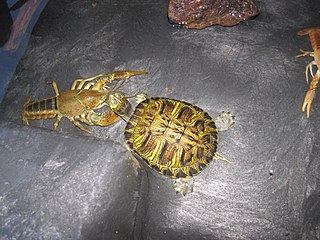 W
WProcambarus zonangulus, the white river crawfish, white river crayfish or southern white river crayfish, is a species of freshwater crayfish.
 W
WThe rusty crayfish is a large, aggressive species of freshwater crayfish which is native to the United States, in the Ohio River Basin in parts of Ohio, Kentucky, and Indiana. Its range is rapidly expanding across much of eastern North America, displacing native crayfishes in the process. The rusty crayfish was first captured in Illinois in 1973, and has been collected at over 20 locations in the northern portion of the state. In 2005, F. rusticus was found for the first time west of the Continental Divide, in the John Day River, Oregon, which runs into the Columbia River.